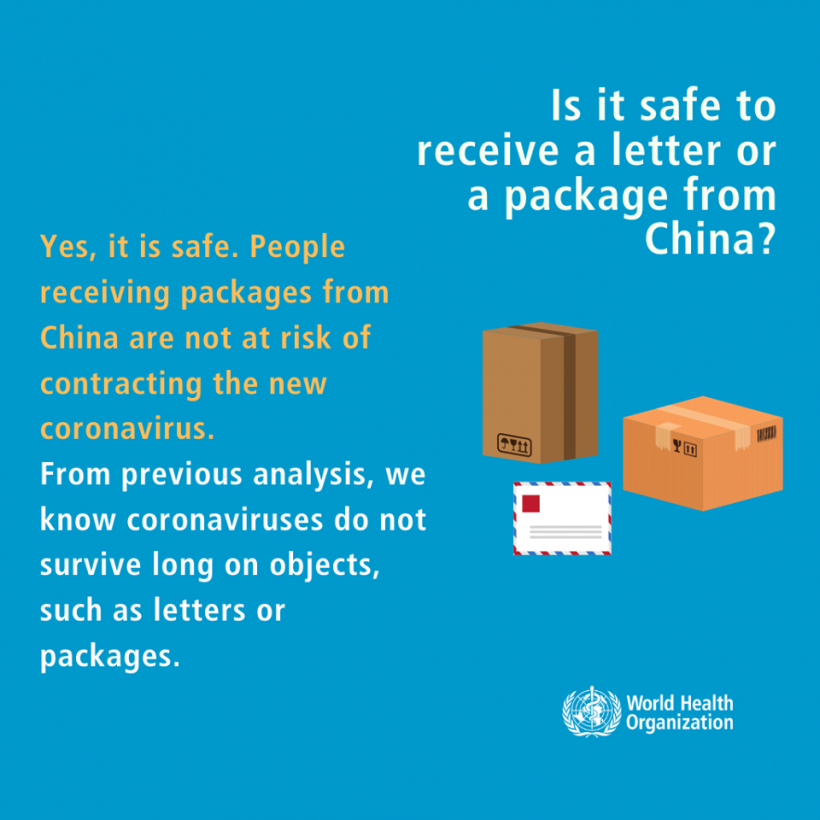世界卫生组织发布从中国发出的货物,不会携带病毒.各国对中国船舶靠泊通知

世界卫生组织WHO近日发表声明:从中国发出到境外的货物,不会携带病毒.
问:从中国收到信件或包裹是否安全?
答:是的,这很安全。从中国接收包裹的人没有感染2019-nCoV的风险。
根据先前的分析,我们知道冠状病毒不能在诸如信件或包裹之类的物体上长期存活。
取消所有经停受疫情影响国家港口的船舶直接进入码头泊位的权利。 这些船舶上的相关工作人员不得下船。 如果有报告疑似病例,该船所有船员将被统一隔离。 如果这些船舶得到了可以卸货的许可。在靠泊、卸货时,码头操作人员需与这些船舶上的人员需保持安全距离,佩戴口罩、护目镜等防护措施。 继续加强卫生管理,包括避免人群聚集、确保安全距离等。 来自中国的船舶上废弃物需要严格管理。 越 南 越南卫生部发布公告,在海防港口,将对来自中国等新型冠状病毒高发国家的船舶,采取一系列管控措施!以避免病毒通过船舶等形式输入越南,船舶必须在特定的地方抛锚检测隔离14天后才能靠港. 越南暂停中越来往航班,暂停对近14天内在中国生活过的人发签证,同时也停止与冠状病毒肺炎相关的医疗物品出口. 越南关闭陆路口岸清关.因防控新型冠状病毒感染的肺炎疫情工作需要,2月3日晚越南同登-谅山口岸经济区管委会正式通报我方,2020年2月4日起越南友谊口岸暂缓办理货物清关手续,建议各位客商合理安排货物通关事宜。 新加坡 MPA新加坡海事及港务管理局有在2月1日发布港口海事通告如下,紧随新加坡政府1月31日禁止过去14天到过中国大陆的游客入境的通知之后,注意第三点指出MPA将把预防措施扩展到在过去14天内有最近到中国大陆旅行历史的乘客和船员,以及在过去14天内停靠过中国大陆港口的船舶。这已于2020年2月1日2359生效。 即增加对人及船的各种检疫流程,势必增加非生产性停泊的时间影响正常作业计划,繁忙的新加坡港遇上大比例靠泊过中国大陆港的船舶,料每套流程的叠加新加坡的拥堵会是大概率事件。 马来西亚 马来西亚卫生部在入境处采取了多项防范措施,在全国64个入境处都有设有临时体温筛检处。据该国卫生部长拿督斯里祖基菲里说:“目前马来西亚数个主要的入境处有54台体温扫描器,任何被侦测到发烧的旅客,都会由医护人员再次检查以确认是否发烧。” 他表示,医护人员会询问旅客在抵达大马前2周内在中国的行程情况,如旅客符合疑似病例,将被转到医院接受进一步治疗。“对于非疑似病例的旅客,将会被给予隔离器具,将他们隔离长达14天,咳嗽但没有发烧的旅客将会被给予口罩,以防止疾病传播。” 同时,没有任何症状的旅客,将会被给予健康警示卡,并告知他们,如若在抵达14天内出现发烧、咳嗽或呼吸困难症状,在寻求医药治疗时需携带健康警示卡。 拿督斯里祖基菲里还介绍,各大入境口都挂上了横幅,以告知和鼓励来自中国的游客自愿前往入境处健康检查中心,进行自愿申报。“在港口方面,所有来自中国的船舶都将被隔离,直到马来西亚卫生部官员对船舶进行检查为止。如果检查发现所有乘客和船员都健康,并且船舶卫生文件仍然有效,则允许船员和乘客下船和进行卸货活动。” 来自中国的船只一旦进入马来西亚港口,马来西亚卫生局将会在船只驶入码头后,要求船员在指定的检疫区进行隔离。 科威特 科威特港口当局建议要求所有直接或过境中国港口的船长提供一份声明,声明中船上没有发现任何症状,如高温、喉咙痛、咳嗽或呼吸困难。如果船上发生此类事件,将立即通知港务局。 巴 西 (2020.01.31) 1、首先,需要注意的是,中国和巴西之间的船只平均航行时间为45天,远超新型冠状性病毒14天的潜伏期。因此,根据迄今所进行的风险评估,有以下几点值得注意。 2、要正确填写“海事健康声明”(Maritime Health Declaration)以便相关评估的进行及检疫证明(Free Pratique)的签发。需要强调的是签发检疫证明的需求需要提前48或72小时提出,以便ANVISA在船舶允许挂靠前进行评估。 3、船员或旅客健康状况的任何变化必须立即向卫生当局报告。如果2019-nCoV疑似病例在船上,将签发检疫证明(Free Pratique),并启动当地应急计划,必要时将考虑将指定的船员送往医院。 4、根据卫生部的《流行病学通报》(第51卷第04期),疑似病例应予以隔离并使用外科口罩。接触疑似病例的其他船员必须佩戴PPE(外科口罩、护目镜或面罩、手套、防护服等等)。 阿根廷 1、该国健康部门表示阿根廷是一个低风险国家。 2、但是,从1月31日起,在船舶到达前申请检疫证明(Free Pratique)时,必须提供船舶过去48小时内的医疗记录副本。 3、卫生当局还建议,如果有人怀疑国际航行中的任何船员或乘客可能患有传染病或类似的2019-nCoV冠状病毒症状,应立即通知健康部门。在这种情况下,卫生官员将提供相应的指示,但疑似病例必须隔离(在船上的船舱或岸上的旅馆),等待相关指示。 4、目前没有任何旅行和贸易限制。 OES小编将继续跟踪各国对中国疫情影响通知,敬请关注!
